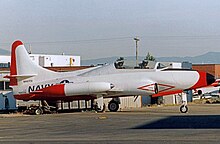| This article includes a list of general references, but it lacks sufficient corresponding inline citations. Please help to improve this article by introducing more precise citations. (September 2010) (Learn how and when to remove this message) |
| T2V-1 / T-1 SeaStar | |
|---|---|
 Lockheed T-1A Seastar in 1959 Lockheed T-1A Seastar in 1959 | |
| General information | |
| Type | carrier-capable trainer |
| Manufacturer | Lockheed |
| Primary user | United States Navy |
| Number built | 150 |
| History | |
| Introduction date | May 1957 |
| First flight | 15 December 1953 |
| Retired | 1970s |
| Developed from | Lockheed T-33 |

The Lockheed T2V SeaStar, later called the T-1 SeaStar, is a carrier-capable jet trainer for the United States Navy that entered service in May 1957. Developed from the Lockheed T-33 (itself derived from the Lockheed P-80 Shooting Star), it was powered by one Allison J33 engine.
Design and development
Starting in 1949, the U.S. Navy used the Lockheed T-33 for land-based jet aircraft training. The T-33 was a derivative of the Lockheed P-80/F-80 fighter and was first named TO-2, then TV-2 in Navy service. However, the TV-2 was not suitable for operation from aircraft carriers. The persisting need for a carrier-compatible trainer led to a further, more advanced design development of the P-80/T-33 family, which came into being with the Lockheed designation L-245 and USN designation T2V. Lockheed's demonstrator L-245 first flew on 16 December 1953 and production deliveries to the US Navy began in 1956.
Compared to the T-33/TV-2, the T2V was almost totally re-engineered for carrier landings and at-sea operations with a redesigned tail, naval standard avionics, a strengthened undercarriage (with catapult fittings) and lower fuselage (with a retractable arrestor hook), power-operated leading-edge flaps (to increase lift at low speeds) to allow carrier launches and recoveries, and an elevated rear (instructor's) seat for improved instructor vision, among other changes. Unlike other P-80 derivatives, the T2V could withstand the shock of landing on a pitching carrier deck and had a much higher ability to withstand sea water-related aircraft wear from higher humidity and salt exposure.
Operational history
The only version of the T2V was initially designated T2V-1 when it entered service, but was redesignated T-1A SeaStar under the 1962 United States Tri-Service aircraft designation system, the designation under which it would spend the majority of its career.
The T-1A was replaced by the North American T-2 Buckeye but remained in service into the 1970s.
Operators

Surviving aircraft
As of 2017, one T2V-1A airworthy, based at Phoenix-Mesa Gateway Airport (former Williams Air Force Base) in Mesa, Arizona, and being flown for experimental and display purposes. Two examples are preserved on public display in Tucson, Arizona.
Specifications (T2V-1)

Data from Lockheed Aircraft since 1913
General characteristics
- Crew: Two (student & instructor)
- Length: 38 ft 6.5 in (11.75 m)
- Wingspan: 42 ft 10 in (13.06 m)
- Height: 13 ft 4 in (4.06 m)
- Wing area: 240 sq ft (22.3 m)
- Empty weight: 11,965 lb (5,427 kg)
- Gross weight: 15,500 lb (7,031 kg)
- Max takeoff weight: 16,800 lb (7,636 kg)
- Powerplant: 1 × Allison J33-A-24/24A turbojet, 6,100 lbf (27 kN) thrust
Performance
- Maximum speed: 580 mph (933 km/h, 504 kn) at 35,000 ft (10,670 m)
- Range: 970 mi (1,560 km, 843 nmi)
- Service ceiling: 40,000 ft (12,190 m)
- Rate of climb: 6,330 ft/min (32 m/s)
See also
Related development
Aircraft of comparable role, configuration, and era
References
- Notes
- Swanborough p. 297
- "FAA REGISTRY N-Number Inquiry Results N447TV is Assigned". registry.faa.gov. Federal Aviation Administration. 21 July 1999. Archived from the original on 10 December 2017. Retrieved 10 December 2017.
- Ogden, p. 98
- Francillon 1982, pp. 321–322.
- Bibliography
- Francillon, René J. Lockheed Aircraft since 1913. London:Putnam, 1982. ISBN 0-370-30329-6.
- Ginter, Steve. Lockheed T2V-1/T-1A Seastar. Naval Fighters #42. Simi Valley, California: Ginter Books, 1999. ISBN 978-0-942612-42-4.
- Ogden, Bob. Aviation Museums and Collections of North America. 2007. Air-Britain (Historians) Ltd. ISBN 0-85130-385-4.
- Swanborough, Gordon, with Bowers, Peter M. United States Navy Aircraft since 1911. 1990. Putnam Aeronautical Books. ISBN 0-87021-792-5.
- Green, William, with Gerald Pollinger. The Aircraft of the World. New York; Doubleday & Co., 1965. P. 255.
- Green, William, with Dennis Punett. MacDonald World Air Power Guide. London; Purnell & Sons, Ltd. (reprinted by Doubleday), 1963. P. 28.
External links
- Naval Aviation Chronology 1954–1959 chapter from United States Naval Aviation 1910–1995 book. Archived 14 March 2007 at the Wayback Machine
| Lockheed P-80 Shooting Star family | |||||||
|---|---|---|---|---|---|---|---|
| Model numbers | |||||||
| Aircraft | |||||||
| Foreign variants |
| ||||||
| Topics |
| ||||||
| Lockheed and Lockheed Martin aircraft and spacecraft | |||||||||||||
|---|---|---|---|---|---|---|---|---|---|---|---|---|---|
| Transports |
| ||||||||||||
| Fighter-bombers |
| ||||||||||||
| Reconnaissance |
| ||||||||||||
| Trainers | |||||||||||||
| Helicopters | |||||||||||||
| Experimental | |||||||||||||
| Light aircraft | |||||||||||||
| Missiles | |||||||||||||
| Engines | |||||||||||||
| Model numbers |
| ||||||||||||
| Not assigned | |||||||||||||
| USN/USMC trainer aircraft designations pre–1962 | |||||||||||||||||||||||||||||||||||
|---|---|---|---|---|---|---|---|---|---|---|---|---|---|---|---|---|---|---|---|---|---|---|---|---|---|---|---|---|---|---|---|---|---|---|---|
| N-series (1922–1948) |
| ||||||||||||||||||||||||||||||||||
| T-series (1948–1962) |
| ||||||||||||||||||||||||||||||||||
| |||||||||||||||||||||||||||||||||||
| United States trainer aircraft designations, Army/Air Force and Tri-Service systems | |||||
|---|---|---|---|---|---|
| Advanced trainer (1925–1948) | |||||
| Basic combat (1936–1940) | |||||
| Basic trainer (1930–1948) | |||||
| Primary trainer (1924–1948) | |||||
| Main sequence (1948–present) |
| ||||
| Alternate sequences |
| ||||
| Not assigned • Assigned to multiple types | |||||